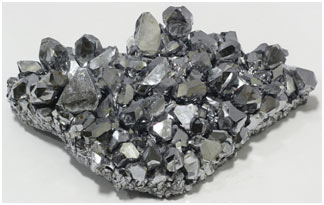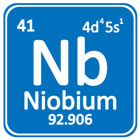Introduction
Niobium is the transition element located in group number 5 and period number 5 of the periodic table. The atomic number of niobium is 41 whereas its atomic mass is 92.90. The single neutral atom of niobium contains 41 electrons.
The nucleus of niobium contains 41 protons and 52 neutrons. It is represented by the symbol “Nb”.
Naming and History
The name Niobium is from the Greek word “Niobe” the Greek mythological figure. Niobe was the daughter of King Tantalus. It was named because it has a chemical similarity to tantalum.
- Charles Hatchett
In 1801, Charles Hatchett while visiting and examining minerals at a British museum came across a specimen labeled columbite. That was an American ore sent to the British Museum more than a century ago.
He examined and suspected a new element in it. Hatchett heated columbite with potassium carbonate dissolved the product in water then added acid and finally obtained the precipitate. But he was unable to produce pure element. He named that element columbium from columbite.
- Heinrich Rose
After the discovery of Tantalum, the columbium was doubted as both occur together and seemed to be inseparable. In 1846, German chemist Heinrich Rose found that columbite contains both tantalum and a new element which he named niobium.
- Christian Blomstrand
In 1864, Swedish scientist Christian Blomstrand first isolated the pure niobium element. He did so by reducing niobium chloride in the hydrogen atmosphere.
Occurrence of Niobium
Niobium does not occur in its free elemental state in nature. Niobium mainly occurs in two chief ores which are columbite and pyrochlore. Plants, lichens and mosses show trace quantities of absorbed niobium. The major minors of niobium are Brazil which produces 85% of the world’s niobium. Others are Canada, Congo, Russia and Nigeria. Some quantities are also obtained as a by-product of tin extraction.

Properties of Niobium
Niobium is a lustrous, whitish-grey, soft, corrosion-resistant, malleable and ductile transition metal. Its structure is body-centered cubic crystalline. Its physical and chemical properties show great resemblance to tantalum.
When exposed to air, an oxide layer of different shades according to the thickness of layer is formed. Mostly bluish-green and yellowish shades are observed. It is corrosion resistant due to the formation of the oxide layer. At high temperatures of 200 ᵒC, the metal begins to oxidize rapidly.
Due to its high reactiveness towards oxygen, hydrogen, nitrogen and sulphur; it is always kept in special protective atmospheres. Niobium does not react with acids or even aqua regia at room temperature. But is greatly attacked by concentrated hot acids and alkalies.
The melting point of niobium is 2477°C and its boiling point is 4744°C. It has a density of 8.57 grams per cubic centimeter. Niobium exists in the solid phase at room temperature.
Niobium in Biological Systems
There is no role of niobium has been observed in living organisms. Also, niobium is considered to be non-toxic as no cases of niobium poisoning are reported.
Uses of Niobium
- Niobium is alloyed with iron and other metals such as zirconium for stainless steel. These alloys are also used in rockets, missiles, jets, oil and gas rigs and pipelines.
- Niobium alloys are used in nuclear reactors, cutting tools and welding rods.
- The pure form of niobium is used in manufacturing superconductors and wires which are capable of strong magnetic fields.
- Surgical devices and implants are made by using niobium.
- Superconductive niobium is used in accelerators for particles.
- It is used in jewelry.
- Niobium has a good refractive index. Its oxides are used in glass, manufacturing with a greater refractive index.
Isotopes of Niobium
There are almost 28 known isotopes of niobium whose mass number ranges from 83 to 110. The one stable naturally occurring isotope of niobium is Nb- 93.
MCQs
- What is the atomic number of niobium?
- A) 41
- B) 92.90
- C) 52
- D) 5
- Answer: A) 41
- Who is credited with the discovery of niobium?
- A) Charles Hatchett
- B) Heinrich Rose
- C) Christian Blomstrand
- D) Niobe
- Answer: B) Heinrich Rose
- What is the structure of niobium?
- A) Face-centered cubic crystalline
- B) Hexagonal close-packed crystalline
- C) Body-centered cubic crystalline
- D) Simple cubic crystalline
- Answer: C) Body-centered cubic crystalline
- Which two ores mainly contain niobium?
- What is the major producer of niobium in the world?
- A) China
- B) Brazil
- C) Canada
- D) Russia
- Answer: B) Brazil
- Which type of atmosphere is niobium kept in due to its high reactivity?
- A) Oxygen
- B) Nitrogen
- C) Protective
- D) Inert
- Answer: D) Inert
- What is the melting point of niobium?
- A) 200°C
- B) 2477°C
- C) 4744°C
- D) 8.57 g/cm³
- Answer: B) 2477°C
- What are niobium alloys used for in the aerospace industry?
- A) Making jewelry
- B) Surgical implants
- C) Rockets and missiles
- D) Glass manufacturing
- Answer: C) Rockets and missiles
- Which industry utilizes niobium alloys for their superconductivity?
- A) Nuclear reactors
- B) Oil and gas rigs
- C) Jewelry manufacturing
- D) Particle accelerators
- Answer: D) Particle accelerators
- What is the only stable naturally occurring isotope of niobium?
- A) Nb-52
- B) Nb-83
- C) Nb-93
- D) Nb-110
- Answer: C) Nb-93
- What is the historical origin of the name “niobium”?
- A) Latin word for “shiny”
- B) Greek mythological figure
- C) Chinese philosopher
- D) German chemist
- Answer: B) Greek mythological figure
- How did Charles Hatchett initially name the element later known as niobium?
- A) Columbite
- B) Tantalum
- C) Columbium
- D) Niobe
- Answer: C) Columbium
- Who successfully isolated the pure niobium element in 1864?
- A) Charles Hatchett
- B) Heinrich Rose
- C) Christian Blomstrand
- D) Niobe
- Answer: C) Christian Blomstrand
- What role does niobium play in living organisms?
- A) Structural support
- B) Essential nutrient
- C) No observed role
- D) Catalyst in biochemical reactions
- Answer: C) No observed role
- In which industrial application is the pure form of niobium commonly used?
- A) Jewelry manufacturing
- B) Glassmaking
- C) Superconductors
- D) Nuclear reactors
- Answer: A) Jewelry manufacturing
- How many known isotopes of niobium are there?
- A) 7
- B) 17
- C) 28
- D) 37
- Answer: C) 28
- What is the density of niobium?
- A) 200 g/cm³
- B) 2477 g/cm³
- C) 4744 g/cm³
- D) 8.57 g/cm³
- Answer: D) 8.57 g/cm³
Wrapping up
In conclusion, niobium, a transition element with atomic number 41, plays a significant role in various industrial applications despite its limited occurrence in nature. Its naming history, starting from Charles Hatchett’s discovery of columbium to Heinrich Rose’s identification of niobium, reflects its intriguing journey. Niobium mainly occurs in ores like columbite and pyrochlore, predominantly sourced from countries like Brazil, Canada, and Russia.
Notably, its properties, including corrosion resistance and high melting point, make it indispensable in alloy production for aerospace, nuclear reactors, and medical devices. While niobium lacks biological significance, its isotopes offer diverse avenues for scientific exploration. From enhancing superconductors to facilitating jewelry manufacturing, niobium’s versatility underscores its importance in modern technology and industry.

